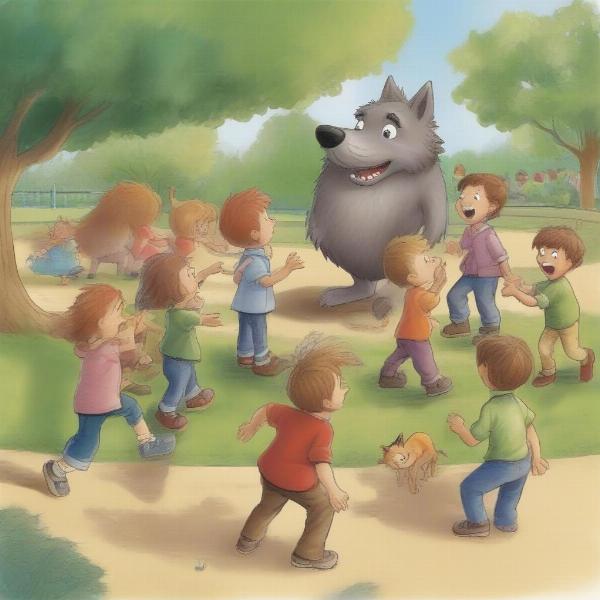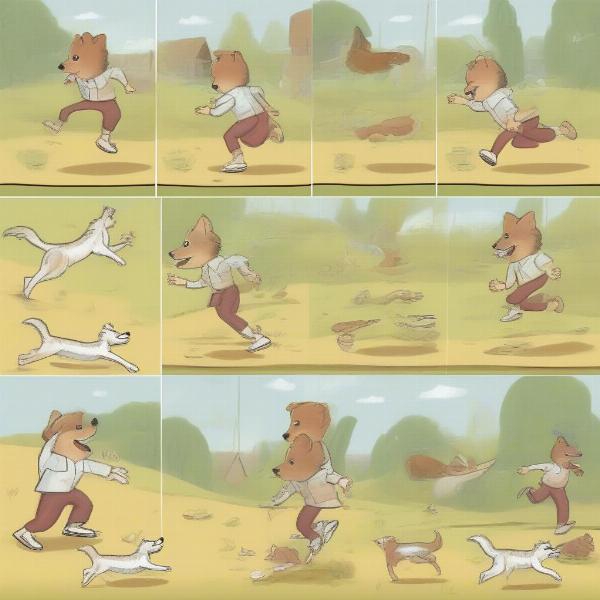The “What Time Is It Mister Wolf?” game is a classic children’s game of chase, blending suspense, strategy, and a healthy dose of fun. It’s a great way for kids to burn off energy while developing crucial skills like listening, following directions, and estimating distance. This comprehensive guide will explore everything you need to know about this timeless game, from its simple rules to variations and the benefits it offers.
Understanding the Basics of What Time Is It Mister Wolf?
This game requires minimal setup and can be played virtually anywhere with a group of children. One player is designated as “Mister Wolf,” while the others stand at a designated starting line, some distance away. The core of the game revolves around the interaction between Mister Wolf and the other players, marked by a rhythmic call and response.
How to Play What Time Is It Mister Wolf?
The gameplay is deceptively simple. The children ask, “What time is it, Mister Wolf?” Mister Wolf then responds with a time, like “2 o’clock” or “5 o’clock.” The children then take the corresponding number of steps forward. This continues until Mister Wolf decides to announce, “It’s dinner time!” At this point, Mister Wolf chases the other players back to the starting line. Anyone tagged by Mister Wolf before reaching safety becomes the new Mister Wolf for the next round.
 Children playing what time is it mister wolf game
Children playing what time is it mister wolf game
Variations and Adaptations of the Game
The basic rules provide a solid foundation, but there’s plenty of room for customization. Some variations include having Mister Wolf choose different “dinner” options, each with a specific action associated with it. For example, “It’s snack time!” might mean hopping back, while “It’s dessert time!” could involve skipping.
Adapting for Different Age Groups
For younger children, shorten the playing distance and use smaller time increments. For older children, increase the distance and introduce more complex variations, such as obstacles or safe zones. This flexibility makes the game suitable for a wide range of ages and abilities.
 Variations of what time is it mister wolf game
Variations of what time is it mister wolf game
Benefits of Playing What Time Is It Mister Wolf?
Beyond the sheer fun, this game provides several developmental benefits. It encourages physical activity, enhances listening and comprehension skills, and promotes social interaction. The game also fosters an understanding of basic time concepts and helps children develop spatial awareness.
Developing Social Skills
“What Time Is It Mister Wolf?” encourages teamwork and cooperation, as children learn to work together to avoid being caught. It also helps develop important social skills like taking turns and following rules.
“Playing ‘What Time Is It Mister Wolf?’ provides a fantastic opportunity for children to develop vital social and cognitive skills in a fun and engaging environment,” says Dr. Amelia Carter, Child Development Specialist.
What Time Is It Mister Wolf? in Different Cultures
While widely known by this name, similar chase games exist in various cultures worldwide. These variations often involve different characters and thematic elements, reflecting local traditions and folklore.
The Global Impact of Chase Games
The universality of these games highlights the importance of play in child development across different societies. Regardless of the specific name or characters, the underlying principles of chase, strategy, and social interaction remain consistent.
 Children playing variations of what time is it mister wolf game around the world
Children playing variations of what time is it mister wolf game around the world
Tips for a Successful Game of What Time Is It Mister Wolf?
To maximize the enjoyment and benefits of the game, consider these tips:
- Choose a safe playing area: Ensure the designated playing space is free of obstacles and hazards.
- Establish clear rules: Before starting, clearly explain the rules and any variations you’ll be using.
- Encourage fair play: Emphasize the importance of taking turns and respecting the designated “Mister Wolf.”
- Adapt the game to the players: Adjust the playing distance and complexity of the rules to suit the age and abilities of the participants.
Conclusion
“What Time Is It Mister Wolf?” remains a beloved childhood game for its simplicity, excitement, and developmental benefits. By understanding the rules, variations, and benefits, you can ensure a fun and enriching experience for all players. So, gather your friends, pick your Mister Wolf, and get ready to play this classic game of chase!
FAQs
-
How many players are needed for “What Time Is It Mister Wolf?” The game can be played with a minimum of three players, but is more enjoyable with a larger group.
-
Can adults play “What Time Is It Mister Wolf?” Absolutely! It’s a fun game for all ages and can be adapted to suit different levels of physical activity.
-
What are some alternative names for this game? Similar games are played worldwide under different names, such as “Grandmother’s Footsteps” or “Red Light, Green Light.”
-
What skills does “What Time Is It Mister Wolf?” help develop? The game enhances listening skills, spatial awareness, following directions, and social interaction.
-
Can the game be played indoors? Yes, the game can be played indoors, provided there is enough space to move around safely.
-
What are some other games similar to “What Time Is It Mister Wolf?” Other chase games like tag, hide-and-seek, and British Bulldog share similar elements of running and catching.
-
How can I make the game more challenging? Introduce obstacles, safe zones, or more complex variations to increase the difficulty for older children.
“Engaging in traditional games like ‘What Time Is It Mister Wolf?’ offers children a break from screen time and encourages active play while building essential social skills.” says Ms. Sarah Johnson, Early Childhood Educator.

